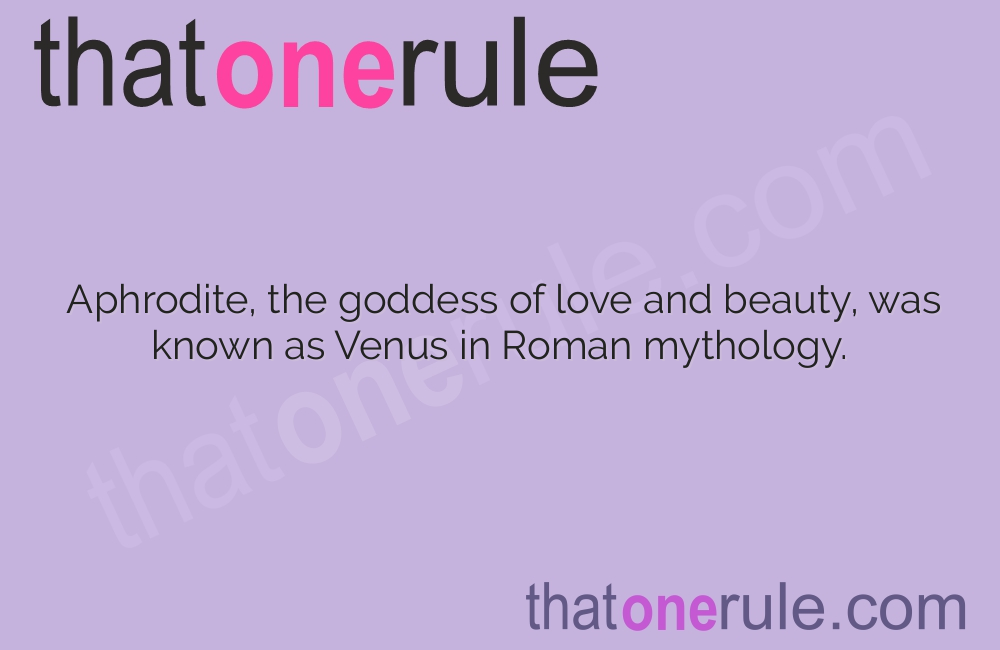Fascinating Trivia about Aphrodite

Aphrodite, the goddess of love and beauty, was known as Venus in Roman mythology.
According to Greek mythology, Aphrodite was born from the sea foam when the Titan Cronus castrated his father, Uranus, and threw his genitals into the sea.
Aphrodite’s birthplace is said to be in the island of Cyprus.
Aphrodite had many temples dedicated to her throughout ancient Greece.
Aphrodite was married to Hephaestus, the god of blacksmiths and craftsmen, but she had multiple affairs with other gods and mortals.
Aphrodite’s symbols included the dove, swan, and rose.
The name Aphrodite is derived from the Greek word aphros, which means foam.
Aphrodite is often depicted with a magical girdle, called the Cestus, which enhances her irresistible charm.
Aphrodite was considered to be the most beautiful of all the goddesses.
Aphrodite was associated with love, desire, fertility, and beauty.
In some myths, Aphrodite is said to have caused the Trojan War due to her involvement with Paris of Troy.
Aphrodite had several children, including Eros (Cupid), the god of love.
Aphrodite was worshipped through various festivals and rituals, including the Aphrodisia, celebrated in her honor.
Aphrodite was often depicted with a mirror, symbolizing her vanity and self-admiration.
Aphrodite’s lover, Adonis, was a mortal prince who was killed by a wild boar and later transformed into a flower.
Fascinating Trivia about Aphrodite part 2
Aphrodite’s beauty was so captivating that even the gods and goddesses themselves were often infatuated with her.
Aphrodite was said to have a magical girdle that could make any man fall in love with her.
Aphrodite had a close connection with the sea and was often depicted emerging from the waves.
Aphrodite was sometimes referred to as the protectress of sailors and seafarers.
Aphrodite was believed to have the power to inspire love and desire in both gods and mortals.
Aphrodite’s sacred animals were the dove and the swan.
In some myths, Aphrodite is said to have been born from the blood of Uranus falling into the sea.
Aphrodite’s beauty was said to be so overwhelming that even other goddesses would envy her.
Aphrodite was often accompanied by Eros, her son and the personification of romantic love.
Aphrodite was believed to have the power to bring harmony and reconciliation among lovers.
Aphrodite’s influence extended beyond Greece and was also worshipped in ancient Mesopotamia and Egypt.
Aphrodite was said to have a magical girdle made by Hephaestus, which she used to seduce and manipulate others.
Aphrodite was known for her numerous affairs with gods, mortals, and even animals, leading to many mythical love stories.
Aphrodite was associated with gardens, as she was believed to have the power to make plants flourish.
Aphrodite was often depicted as a young and beautiful woman, sometimes with golden hair and rosy cheeks.
Aphrodite had a rivalry with Athena, the goddess of wisdom and warfare, as they both sought the title of the most beautiful goddess.
Aphrodite was worshipped by courtesans and prostitutes, who sought her blessings for their profession.
Aphrodite was said to have risen from the sea on a scallop shell, which became one of her sacred symbols.
In some versions of Aphrodite’s birth, she emerged fully grown and fully clothed from the sea foam.
Aphrodite was known for her passionate and impulsive nature, often acting on her desires without considering the consequences.
Aphrodite had many temples and shrines dedicated to her, including the famous Temple of Aphrodite at Aphrodisias in Turkey.
Aphrodite’s power was believed to extend not only to romantic love but also to friendship, familial love, and even self-love.
Aphrodite was often depicted in art and sculpture, showcasing her beauty and sensuality.
Aphrodite was called Aphrodite Pandemos to represent her role in love and desire for all people, not just the gods.
Aphrodite was believed to have a magical girdle that could even make the most virtuous and chaste individuals fall in love.
Aphrodite was often invoked in prayers and rituals related to fertility and conception.
Aphrodite’s divine beauty caused envy and competition among other goddesses, such as Hera and Athena.
Aphrodite’s association with roses led to the belief that the flower was her sacred flower, representing love and beauty.
Aphrodite’s love affairs often brought chaos and turmoil to both the mortal and immortal realms.
Aphrodite’s allure and her ability to ignite passion and desire made her a powerful and complex figure in Greek mythology.

